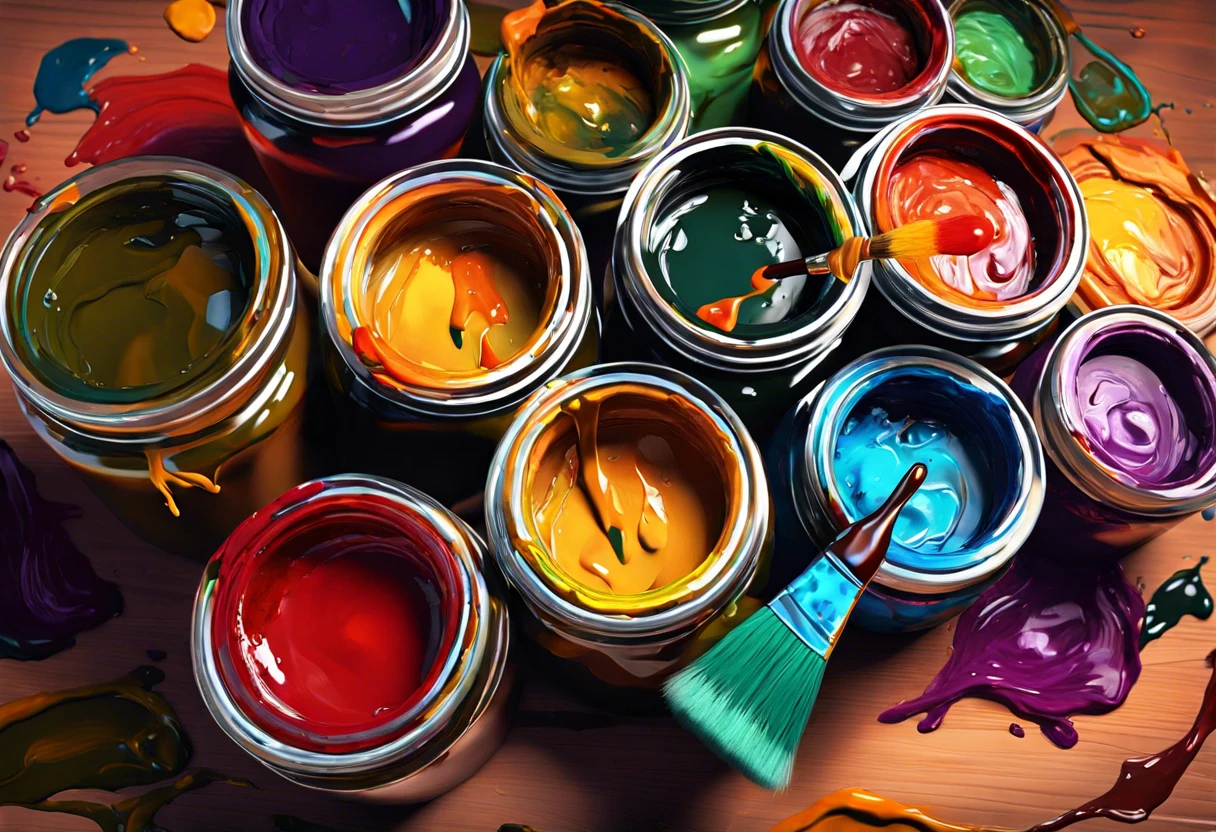What is the Best Solvent for Cleaning Oil Paint Brushes?
Published on: October 26, 2025 | Last Updated: October 1, 2025
Written By: paint_answered
Oil paint brushes are special tools artists use to create beautiful designs with thick colors. They soak up paint and let you add magic to your canvas!
Knowing what is the best solvent for cleaning oil paint brushes is super important. I’ve learned the hard way that using the wrong one can ruin your favorite brushes.
In this guide, you’ll find essential steps for preparations, a step-by-step cleaning process, recommended cleaning solutions, and common issues to avoid. We’ll also explore types of solvents, key factors to consider when picking one, and even some DIY project ideas for your cleaned brushes. You’ll never wonder how do you clean oil paint off brushes again!
Contents
- 1 What is the Best Solvent for Cleaning Oil Paint Brushes?
- 2 What Are Oil Paint Brushes?
- 3 Essential Preparations Before You Start Cleaning
- 4 Step-by-step Guide to Cleaning Your Oil Paint Brushes
- 5 Recommended Cleaning Solutions for Oil Paint Brushes
- 6 Types Of Solvents Best for Cleaning Oil Paint Brushes
- 7 Key Factors Affecting Solvent Choice for Cleaning Oil Paint Brushes
- 8 How to Choose the Right Solvent for Your Painting Style
- 9 Comparing Solvent Effectiveness
- 10 Popular Alternative Solvents for Cleaning Oil Paint Brushes
- 11 Environmental Considerations in Solvent Choices
- 12 Common Issues When Cleaning Oil Paint Brushes and How to Avoid Them
- 13 Finishing Touches: Ensuring the Longevity Of Your Brushes
- 14 Frequently Asked Questions About Cleaning Oil Paint Brushes
- 15 Conclusion: Making the Right Choice for Cleaning Oil Paint Brushes
- 16 Additional Resources
What is the Best Solvent for Cleaning Oil Paint Brushes?
The best solvents for cleaning oil paint brushes are mineral spirits or turpentine. These effectively dissolve oil paint while keeping your brushes in shape. After using, rinse with soap and water. Treat your brushes well; they’ll last longer! If you’re exploring alternative painting techniques, you might want to check out creative painting methods for pumpkins.
The Finishing Touch
A freshly painted wall is a blank canvas. The best way to bring your room to life is with a single piece of statement art that ties everything together.
Browse Wall Art at Big Wall DecorWhat Are Oil Paint Brushes?
Oil paint brushes are specialized tools designed for oil paints. They typically have long handles, around 30 cm (12 Inches), and bristles made from natural hairs, like hog or squirrel, which hold more paint and provide better control.
When it comes to cleaning, a good solvent makes a big difference. When I first started oil painting, I learned the hard way about keeping brushes in top shape. Using the right cleaner, like mineral spirits, can improve your brush cleaning techniques! If you’re curious about alternative cleaning methods for art supplies, you might want to explore safe painting techniques and solutions.
I’ve seen people get a lot of use out of it to freshen up old brushes. A simple dip can often remove stubborn residue, making painting more enjoyable! To clean oil paint off brushes without damaging them, research products that minimize wear and tear. If you’re wondering about mixing different paint types, you might want to paint compatibility techniques. So, invest time in learning the right methods.
Essential Preparations Before You Start Cleaning
What do you need to clean your oil paint brushes?
- Odorless Mineral Spirits: You’ll need a solvent like Gamblin Odorless Mineral Spirits or Grumbacher Mineral Thinner. They’re effective for breaking down oil paint.
- Brush Soap: Use products like The Masters Brush Cleaner or Da Vinci Brush Soap. They keep your bristles soft and manageable after cleaning.
- Containers: You need a jar or bucket for rinsing. A separate rinse container makes the cleaning process smoother.
- Rags or Paper Towels: Use absorbent materials like Bounty Paper Towels or reusable cotton rags to wipe off excess paint.
You should now have a good understanding of essential preparations for cleaning. In the next part, we’ll discuss a step-by-step cleaning guide for your oil paint brushes.
Also See: Can You Mix Tempera and Acrylic Paint? What to Know!

The Finishing Touch
A freshly painted wall is a blank canvas. The best way to bring your room to life is with a single piece of statement art that ties everything together.
Browse Wall Art at Big Wall DecorStep-by-step Guide to Cleaning Your Oil Paint Brushes
Here are steps for selecting the best solvent for oil paint brushes. Follow them closely for the best results!
-
Choosing the Right Solvent
For cleaning oil paint, use odorless mineral spirits or turpentine. Choose a solvent that’s gentle on your brushes but effective on paint; a 500 mL (17 Oz) can should last for many sessions.
If you’re sensitive to strong odors, try a natural option, like citrus-based solvents. They may take longer, but they’re worth it if you want to avoid inhaling fumes.
-
Preparation Of Cleaning Area
Ensure your cleaning area is well-ventilated. A space with fresh airflow, like an open window or vent, helps avoid overpowering chemical smells.
Cover your working surface with newspapers or a plastic sheet to catch spills. This protects your furniture and makes cleanup easy!
-
Cleaning Technique
Dip your brush into the solvent, swirling it gently for about 30 seconds. From experience, a light touch helps preserve brush bristles.
Rotate the brush as you clean to reach all angles and remove stubborn paint. Press it gently against the bottom of your container to free up saturated fibers.
-
Final Rinse and Drying
Rinse your brush in clean solvent to remove any remaining paint residue, then wash with soap and lukewarm water. Use mild soap, like dish soap, and rinse until the water runs clear; this prevents buildup! When working with oil-based face paint, proper brush cleaning requires specific techniques to maintain your painting tools effectively.
Gently shape the bristles while drying—lay them flat or hang them up to maintain their form. Your brushes will thank you, and you could significantly extend their life!
So far we covered a guide on cleaning oil paint brushes. Let’s look at recommended cleaning solutions for oil paint brushes next.
Recommended Cleaning Solutions for Oil Paint Brushes
To clean oil paint brushes effectively, use solvent options like turpentine or mineral spirits; they’re the best for breaking down stuck oil.
We have now covered recommended cleaning solutions for oil paint brushes. Next, we will discuss the best solvent types for cleaning them.
Types Of Solvents Best for Cleaning Oil Paint Brushes
Let’s cover the different types of solvents: Mineral Spirits, Turpentine, Vegetable Oils, and Citrus-Based Solvents.
-
Mineral Spirits
Mineral spirits, also known as white spirits, are common in the art world. They’re effective, affordable, and dry quickly, making them great for cleaning oil paint brushes.
-
Turpentine
Turpentine is another popular choice, derived from pine trees. It’s powerful and can dissolve thick paint, but it has a strong odor—use it in well-ventilated areas!
-
Vegetable Oils
Believe it or not, vegetable oils can clean oil paint brushes. They’re gentle, less toxic, and great for artists who want to avoid harsh chemicals.
-
Citrus-based Solvents
Citrus-based solvents use natural orange and lemon extracts. They break down paint effectively and smell pleasant—you’ll love it!
From my experience, Citrus-Based Solvents work wonders. They not only keep my brushes clean but also leave a refreshing scent while I paint!
So far we covered the best solvents for cleaning oil paint brushes. Let’s look at key factors influencing solvent selection next.

Key Factors Affecting Solvent Choice for Cleaning Oil Paint Brushes
What factors influence the best choice for cleaning oil paint brushes?
-
Solvent Composition: Different solvents contain unique chemicals that affect their ability to dissolve oil paint effectively.
-
Brush Material: The type of bristles (Natural Vs. Synthetic) impacts how well a solvent affects brush longevity and performance.
-
Cleanup Ease: Some solvents clean quickly, while others take more time, affecting your painting workflow.
-
Odor and Safety: The strength and fumes of a solvent can influence comfort and health, making some cleaner options preferable.
How to Choose the Right Solvent for Your Painting Style
Your painting style impacts the best solvent for cleaning oil paint brushes. Let’s break it down.
-
Thick, Impasto Techniques
If you often use thick oil paints, opt for turpentine. Its strong power breaks down those stubborn layers while keeping your brushes intact.
-
Delicate, Fine Art Techniques
For detailed work, use odorless mineral spirits. They’re gentle yet effective, ensuring your brushes maintain their shape and performance without harsh chemicals.
-
Mixed Media Work
If you mix media, consider citrus-based solvents. They’re versatile and kind to your brushes, and they leave a pleasant scent—perfect for a creative environment!
Comparing Solvent Effectiveness
Not all solvents are created equal. Here’s a quick comparison.
| Solvent Type | Effectiveness Rating (1-10) | Drying Time | Odor Level | Environmental Impact |
|---|---|---|---|---|
| Odorless Mineral Spirits | 8 | Fast (10-20 min) | Low | Moderate |
| Turpentine | 9 | Fast (10-15 min) | High | High |
| Vegetable Oils | 5 | Slow (30 min+) | Very Low | Low |
| Citrus-based Solvents | 7 | Medium (20-30 min) | Low | Low |
Popular Alternative Solvents for Cleaning Oil Paint Brushes
There are various alternative solvents that artists love, each with unique benefits.
The Finishing Touch
A freshly painted wall is a blank canvas. The best way to bring your room to life is with a single piece of statement art that ties everything together.
Browse Wall Art at Big Wall Decor-
Hand Sanitizer
Did you know hand sanitizer can work in a pinch? It’s got alcohol, which can dissolve some oil paint. It’s not the best, but if you’re stuck, it might help clean your brushes.
-
Paying Attention to Water-based Alternatives
Water-miscible oil paints can be cleaned with just soap and water. This is a game-changer for beginners! When choosing water-soluble paints, brush cleanup becomes a breeze—no harsh solvents needed. If you’re curious about protecting your painting tools, key clip paint techniques can help preserve your brushes and maintain their quality.
-
Essential Oils
Using essential oils like lavender or tea tree can be refreshing! They have natural cleaning properties and leave a nice scent. Just mix them with a carrier oil for effective cleaning.
Environmental Considerations in Solvent Choices
Choosing an eco-friendly solvent can make a difference. Here’s how to weigh your options.
| Solvent Type | Biodegradability | Toxicity Level (1-10) | Performance on Oil Paint | Cost Overview (USD) |
|---|---|---|---|---|
| Odorless Mineral Spirits | Moderate | 7 | 8 | $10-$15 per 500 mL |
| Turpentine | Low | 8 | 9 | $15-$20 per 500 mL |
| Biodegradable Soy Cleaners | High | 2 | 7 | $10-$12 per 500 mL |
| Citrus-Based Solvents | High | 3 | 7 | $12-$18 per 500 mL |
Common Issues When Cleaning Oil Paint Brushes and How to Avoid Them
A friend of mine struggled with stubborn paint in her brushes. She tried just water, but it didn’t work. Do you know how important solvent choice is?
To fix this, use solvents like mineral spirits or turpentine. They effectively break down dried paint. Always wear gloves and ventilate the area. For tough spots, soak the bristles for 15 minutes—this can save your brushes! If you’re dealing with stubborn paint residue, you might want to explore alternative painting techniques that minimize cleanup challenges.
Finishing Touches: Ensuring the Longevity Of Your Brushes
After finding the right solvent, like odorless mineral spirits (OSM, 500 Ml), rinse your brushes thoroughly in warm, soapy water. Conditioning the bristles with a few drops of linseed oil keeps them supple. If you accidentally get paint on your clothing, you might want to know how to remove acrylic paint stains.
Inspect bristle alignment regularly and use needle-nosed pliers for bent tips. For a precise check, dampen the brush and swipe it across a piece of paper. Look for even, smooth strokes.
If you’ve got a few years of experience, master techniques like using a humidifier (30-50% Relative Humidity) to prolong bristle life by preventing brittleness. Store varnish separately to maintain tip shape.
Frequently Asked Questions About Cleaning Oil Paint Brushes
What is the Most Effective Method for Cleaning Oil Paint Brushes?
Yes, the most effective method for cleaning oil paint brushes involves using solvents like odorless mineral spirits or turpentine. These solvents break down the oils in the paint, ensuring thorough cleaning and preventing bristle damage.
Can I Use Water to Clean Oil Paint Brushes?
No, you can’t use water to clean oil paint brushes. Oil and water don’t mix, so water doesn’t effectively remove oil paint, leaving residue and allowing paint to dry on bristles.
How Do I Store My Brushes After Cleaning?
After cleaning oil paint brushes, store them upright or flat, bristles adrift. This way, you’ll help maintain their shape and prolong their lifespan, saving you money.
Are There Eco-friendly Options for Cleaning Oil Paint Brushes?
Yes, there are eco-friendly options for cleaning oil paint brushes. You can use biodegradable solvents, like soy-based cleaners, which effectively dissolve paint while being safer for the environment. If you’re exploring alternative painting surfaces, you might want to check out painting techniques for wood.
What is the Best Way to Remove Dried Paint From Brushes?
The best way to remove dried paint from brushes is using a brush comb or scraper after soaking the brushes in a solvent overnight. This helps loosen the paint, making cleaning easier.
How Often Should I Clean My Oil Paint Brushes?
You should clean your oil paint brushes after each painting session. Regular cleaning prevents paint buildup, maintaining the brush quality and enhancing your painting results.
Can I Reuse Solvents for Cleaning My Brushes?
Yes, you can reuse solvents for cleaning brushes, but filter them to remove the paint debris. This will prolong the life of the solvent and reduce waste, making it economical.
Also See: How to Clean a Palette Of Oil Paint? Easy Steps!
Conclusion: Making the Right Choice for Cleaning Oil Paint Brushes
Phew, that’s a lot to digest! We covered what oil paint brushes are, essential preparations before cleaning, a step-by-step guide to cleaning, recommended solvent solutions, types of solvents, key factors in solvent choice, common cleaning issues, and tips to keep your brushes lasting longer.
So, what is the best solvent for cleaning oil paint brushes? Simple: it’s the solvent that effectively removes oil paint while being gentle on your brushes. Whether it’s odorless mineral spirits, turpentine, or even vegetable oil, just choose the right one based on the already mentioned factors, including cleaning efficiency and brush longevity.
To further enhance your understanding of brush care and other painting tips, explore our homepage: Paint Answers.
Additional Resources
- Edwards, B. (2012). Drawing on the Right Side of the Brain. New York, NY: TarcherPerigee.









